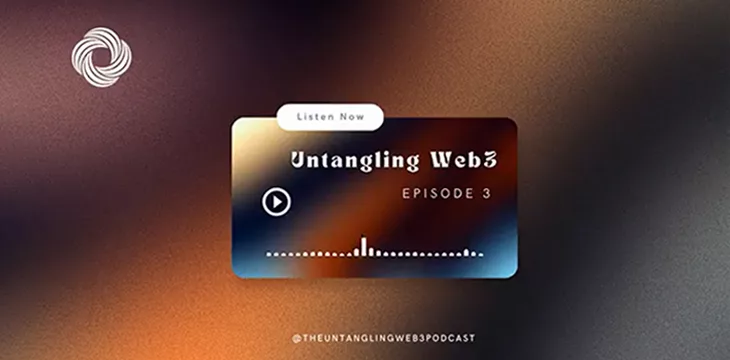|
Getting your Trinity Audio player ready...
|
The third episode of the Untangling Web3 Podcast was all about tokens and tokenization. Tokens are closely tied with the concept of Web3, and as hosts Alec Burns and Jack Davies pointed out right from the start, there is a lot of hype surrounding tokens, especially NFTs.
What are tokens?
Before diving into the meat of the episode, Burns and Davies wanted to provide listeners with a broad explanation of tokens.
“Tokenization generally refers to taking some kind of asset, something of value and that can be any kind of value—physical or digital—representing that in a digital form so it can be easily tracked, transferred, and efficiently used by whatever systems you want,” explained Davies.
“It’s a digital representation of some kind of asset,” he clarified.
Burns added that the episode will focus on blockchain-based tokens in particular and said, “A blockchain-based token is just a representation of those assets using blockchain technology, where blockchain is the medium for representing ownership and also the medium for exchanging that ownership.”
Blockchain is “an all-purpose tool for this idea of tokenization in general,” Burns said.
History of tokenization
While the hype surrounding tokens and tokenization may seem like a new fad to most, Burns pointed out that the concept of tokens is not new. In fact, it goes all the way back to 9000 BC in the form of clay idols that represented cattle, grains, and other goods.
“[Tokens are] a more efficient way of representing an exchange of value,” Burns said.
Davies used the stock exchange as an example of how tokens have been utilized over the years. Until the ’70s, traders used actual certificates until they moved to a digital system.
“This is where digital tokenization first became a mainstream idea,” Davies said.
Tying tokens back to Web3
Seeing as this is a Web3 podcast, the hosts wanted to tie tokens back to the web3 world.
“The concept of tokens is not new. The whole point is to represent goods and services and maybe even access and rights in a more efficient way, a more efficient way to exchange as well,” Burns said.
“Blockchain was the natural evolution of that because it’s the most efficient way to exchange peer-to-peer, for example, and it’s the gold standard for auditability and ownership. So I think that’s how all of this relates to Web3,” he added.
“Tokens are in one sense the fundamental unit or the medium of exchange for web3,” Davies chimed in.
Burns then broke it down into two key principals for relating tokens to Web3:
1. Ownership – the ability to provably say you own something, such as goods or credentials.
2. Peer-to-peer economy – new exchange models for exchanging those things that you own.
Tangible benefits of tokenizing forms of value
Davies posed the question of where we will see the most tangible benefits of tokenizing in addition to the stock exchange. What has the most potential for tokenization?
“I think a good tangible example is any kind of item in which you care about provenance,” Burns answered.
This could mean high-end goods, such as watches that are tokenized on the blockchain as a digital twin, allowing the purchaser to verify the history with complete transparency.
Plastic bottles could be tokenized so their provenance can be proven to U.K. authorities, who will then issue a tax redemption if the bottle is made from recycled materials. Consumers could be rewarded in micropayments for recycling plastic bottles that they use.
“You can use the blockchain as a means to facilitate those interactions in a trusted basis,” Burns stated.
Smart contracts
“Smart contracts” is another one of those buzzwords that we hear all the time but likely don’t fully understand, especially when it comes to tokenized assets.
According to Burns, smart contracts can be thought of as digital forms of traditional pen-and-paper contracts that are stored and typically executed on blockchains. This has the added value of immutability and transparency, he said.
“Smart contracts are a way of encoding some kind of logic, business logic, or some rules to do with the transfer or management of these tokenized assets,” Davies added.
By using smart contracts, we can cut out third parties that just cost money, such as Kickstarter, when it comes to startup funding. You can set up a smart contract instead.
Fungible vs. Non-fungible tokens
“Fungible” and “Non-fungible” may sound like daunting terms at first, but what they mean when it comes to tokens is quite simple.
“Fungibility is defined as the uniqueness or interchangeability of tokens of the same type of equal value and identical properties,” Burns stated.
For example, think of cash—your one-pound coin has the same value as mine; therefore, one-pound coins are fungible tokens. Bitcoin, Ethereum, loyalty tokens—all fungible.
Non-fungible tokens, or NFTs, are essentially the opposite of fungible tokens.
“Every token is very much unique in some sense, so they are distinguishable from one another, and their value can fluctuate wildly depending on the mysterious forces of the market,” said Davies.
He explained how NFTs are partially responsible for popularizing blockchain and Web3 in the eyes of the mainstream because of the digital artworks minted and sold for “eye-watering” amounts of money. However, this is not what excites Davies or Burns about NFTs; it’s the utility of NFTs that excites them.
“I find NFTs extremely exciting because of what I think they can and will be used for,” Burns added.
He used gaming skins as an example of where NFTS get real exciting because they will add value in a social aspect, such as bragging rights for a shiny suit of armor, and they will also provide some sort of utility, such as helping you fight better.
“I really think this idea of social currency in the future is extremely important, and I think it’s going to be one of the reasons why NFTs really do become big,” Burns predicted.
It’s not just this Bored Ape thing, but it will be about utility, he said.
The pair cited crowd-sourcing and royalty sharing as use cases for NFTs with utility where smart contracts set the rules. You could even make illiquid assets liquid. For example, creating an NFT of your house, selling 10% of it, and releasing equity for yourself.
Davies highlighted ticketing as an ideal use case for NFTs and said it’s a great industry that can be disrupted by digital tokenization. He explained how ticketing systems are vulnerable, especially if a physical element is involved. By now, we’ve moved on to an almost fully digital era with ticketing, but what blockchain can add is the secondary market dimension—you can resell your ticket peer-to-peer. Forget fraud or third parties who will take a big cut.
Final thoughts
In closing, Davies mentioned the need for more regulatory clarity over the definition of tokenized assets, how they should be classified, etc. Burns agreed that this is an issue of concern, but wanted to close out the episode on a more positive note.
“The key message from this episode is that tokens generally offer a lot of utility, and it’s all about representing value in a more seamless and efficient way, also for exchanging that value,” he said. “Blockchain-based tokens were the natural evolution for that because it represents one of the most efficient ways to exchange and represent value.”
CoinGeek Conversations with James Belding: Tokenized was built with blood, sweat and tears

 08-18-2025
08-18-2025 





